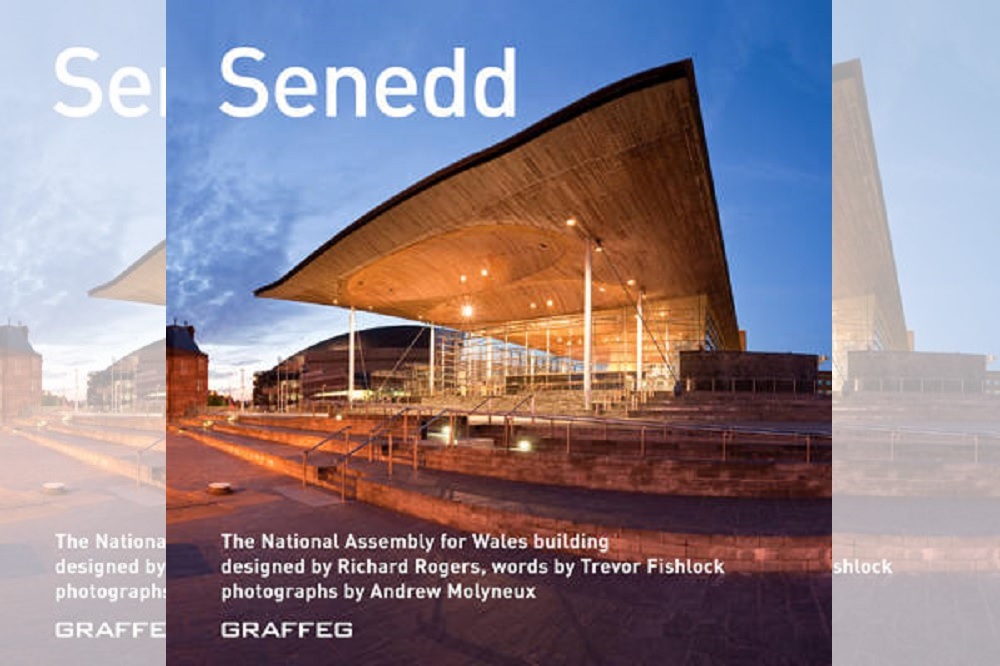Review: Senedd by Trevor Fishlock and Andrew Molyneux

David Lloyd
We live in turbulent times and it seems a lifetime since the Senedd was opened on March 1st, 2006 by the late Queen. Much was invested in the possibility of a stronger, more confident Wales. The new Parliament had a lot resting on its young shoulders and at times the tensions between Westminster and the Welsh Government
As I started to read a newly reissued pocketbook edition of Senedd – the story of its construction and design, written by Trevor Fishlock I began to reflect on my own feelings about it.
Whenever I am in Cardiff and go down the Bay I always gravitate towards the space where the Senedd, The Pier Head Building and The Millennium Centre coexist like some accidental triptych. Each has its own unique identity.
Democratic life
The Senedd speaks of the democratic life of our elected representatives and their wider impact on the lives of Welsh citizens. Many remain conscious of the weight of Westminster but hope for more whether that is further devolution of powers or the independence that is the aspiration of some.
Where it sits is also evocative. As Trevor Fishlock says, “it faces the south-western horizon and the prevailing wind, it draws on the sea and sky.”
Past, present and future are conjoined.
The Pier Head Building’s restored and splendid reminds us of the history of the old Docks and Tiger Bay. When coal was king and the many cultures from across the globe came on ships married and settled in the old heart of the area. Although much of the old Tiger Bay has gone its heritage lives on etched on the faces of people who live in Butetown and those who have moved to other parts of the city.
The Millennium Centre speaks to me of music as a lifelong Welsh National Opera devotee and the artistic talent to be found in every corner of Wales.
Green credentials
The new compact edition of Senedd reminds us of the ecology of the building, the materials used in its creation such as slate and its green credentials. It showcases the creative skills of its architect Ivan Harbour whose initial sketches are part of the story told here.
As a lay person I was struck by the ingenuity of the design and the way it was explored building on layers of illustrations and outlines to express the personality and look of the space.
I particularly enjoyed the interview with Ivan Harbour and the late Richard Rogers where we are taken into the world the architect practice and the work to bring The Senedd to fruition alongside politicians like James Callaghan.
There is also a refreshing honesty about the highs and lows of the project. At one point Rogers and Harbour have to re-tender for it. Did it represent, in the end, a successful outcome? As Rogers says in the interview: “ It’s difficult for the architect to say what is successful. The users are more important at this point.”
Fans and sceptics
We know that modern architecture divides people and opinion. The passage of time, since The Senedd opened officially on St David’s Day in 2006, means that the building has acquired fans and those more sceptical about it.
The book also raises wider questions for me.
How are modern democratic spaces like The Senedd created where debate can flow and people can come and observe the deliberations of our elected representatives? Can they influence these decisions beyond the ballot box?
Is democratic energy and renewal dependent on the design of the building where MSs make laws and hold the Welsh Government to account through debates and questions? How do visitors feel about it? Does it work as a place where there is access and transparency around decision making?
Welsh history
Senedd has a strong historical narrative and its author Trevor Fishlock is particularly skilled at turning the pages of Senedd into an opportunity to reflect on the history of Wales and the men and women who toiled in the Victorian era and the boom years of coal and the wider industries of Wales.
The book examines the history of Cardiff alongside reflections on how The Senedd came into being. Fishlock reminds us of the giants of the era including the Marquess of Bute, John Patrick Crichton-Stuart and his close collaborator and sometime muse the architect William Burges whose legacy lives on in places like Cardiff Castle.
Andrew Molyneux has created stunning photographs which sit alongside fascinating archive images of the old Docks and Tiger Bay. I enjoyed using the latter for detective work and seeing where the past meets the present.
Tiger Bay only gets a page which perhaps underplays its importance to the heritage of the area. Trevor Fishlock does acknowledge that the old area lives on in popular culture and memory but I feel there is more that could have been said about it.
Nevertheless Senedd is a thing of beauty, with its crisp and compelling prose and photography. It would be the perfect present for someone as we approach the beginning of the ever longer build up to Christmas.
Senedd is published by Graffeg and is available from all good bookshops.
Support our Nation today
For the price of a cup of coffee a month you can help us create an independent, not-for-profit, national news service for the people of Wales, by the people of Wales.







Trevor F is one of our national treasures who has helped the peoples of Wales understand their history, institutions and future pathways towards self determination.
A man of the marches with experience of London and a range of international assignments for The Times of London he has offered his adopted home a massive opportunity to learn and expand our horizons.